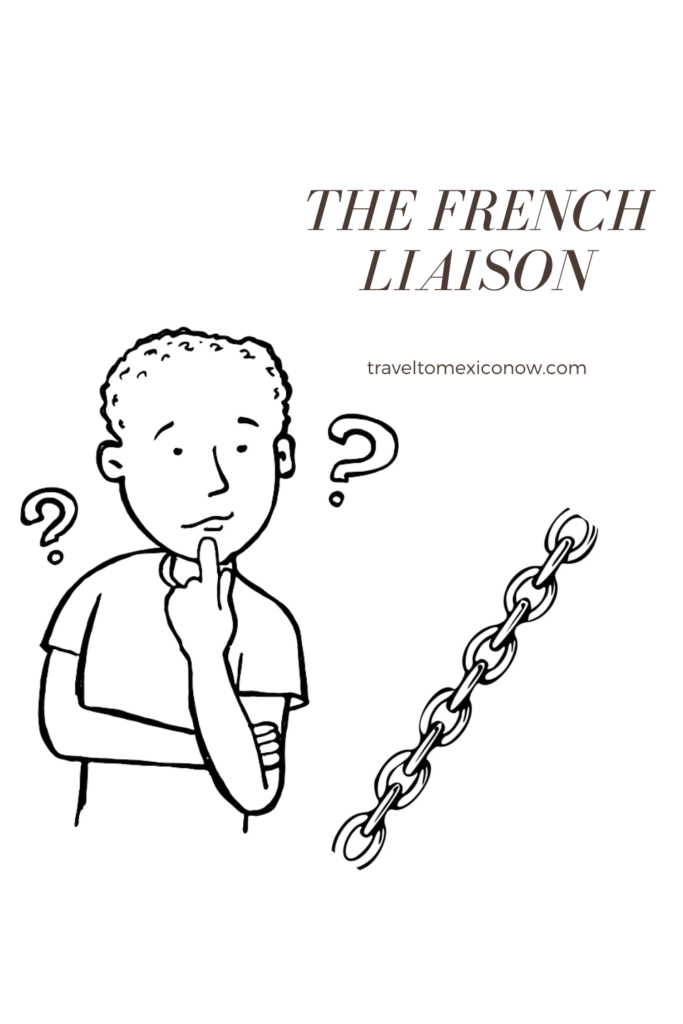If you love the French language or at least if you have ever heard it being spoken, you may have noticed the particularities of the French accent. I’m not talking about the r or nasal sounds, but about the way the French connect some words when they speak. I’m talking about the French liaison.
It is one of the most important aspects of the language. If you want to sound like a native, you have to master it. It can be hard just like other French sounds, especially considering there are many rules and exceptions, but it can be learned.
It’s one of the first things all French students learn. But what is it and how does it work? Don’t worry. We’ve got your back. Allons-y!
What Is the Liaison?

According to Merriam-Webster, a liaison is the pronunciation of an otherwise absent consonant sound at the end of the first of two consecutive words the second of which begins with a vowel sound and follows without pause.
Okay, but what does that mean? Well, for starters, it is important to remember we don’t normally pronounce the last letter of French words save for some exceptions. In some cases, we would have to make abrupt stops when speaking. That is where the liaison comes in.
Simply put, the liaison is the practice of connecting two words by pronouncing the last sound of the first word, which is not normally pronounced.
Look at the following example:
les amis
If you remember the lesson where we learned about articles, you will know that we don’t pronounce the s in les or amis. How would you pronounce it? Leh + ami? Wrong!
In this case, we have to use the liaison. How do we do it? By pronouncing the s in les and connecting it to amis. It would read like leZami as if it were a single word.
When Is It Used?

The French liaison is not that simple. There are several rules and exceptions to it. In some cases, it’s even optional. But don’t fret yet! First, let’s see when we have to use it.
After most subject pronouns
Do you remember the subject pronouns? Well, if you don’t, they’re je, tu, vous, nous, on, il, elle, ils, and elles. Except for je, tu, and elle, most of them end in a consonant. When the subject pronouns ending in a consonant precede a verb that starts with a vowel, we always make a liaison between them.
Examples:
vous êtes (you are)
nous avons (we have)
on est (we are)
After plural determiners
Determiners are words like articles, demonstratives, and adjectives. Unlike English, French determiners have to agree in gender and number. This means that plural determiners will always end in an s.
When a plural determiner precedes a noun that starts with a vowel, we always make a liaison between them.
Examples:
les amis (friends)
mes affaires (my affairs, my business, my stuff)
quels étudiants (which students)
After certain adjectives
In French, adjectives normally go after the noun they modify. However, there are a few cases where they precede a noun. Such is the case of bon/mauvais (good/bad), beau/belle (handsome/beautiful), and grand/petit (big/small).
When one of the adjectives mentioned above precedes a noun that starts with a vowel, we always make a liaison between them.
Examples:
un bon ami (a good friend)
un petit arbre (a small tree)
des belles amandes (beautiful almonds)
After est, très, and bien
Examples:
Il est allé (He went).
Il est très amicable (He is very friendly).
Elle est bien aimée (She is well loved).
After monosyllabic prepositions
Examples:
chez elle. (at her place).
dans un restaurant (at a restaurant)
How Is It Pronounced?
Did you notice a pattern in the examples above? To use a liaison, the first word must end in a consonant, and the word that follows it must start with a vowel.
Having said that, let’s take a look at the different ways that a liaison can be pronounced:
If a word ends in s or x, it is pronounced as z. This is by far the most common liaison.
If a word ends in d or t, it is pronounced as t.
If a word ends in n or m, they’re denasalized and pronounced as n or m, respectively.
In the case of neuf, the f is pronounced as v when preceding ans or heures.
Watch the video below to listen to the pronunciation. Practice as many times as necessary.
When Should We Avoid it?
In some cases, the liaison is never used. Memorize the rules below.
After et
Don’t confuse est (être conjugation) with et (and). Although they are pronounced alike, we make liaisons with est but never with et.
Before words that start with h aspiré
In French, h is never pronounced. However, there are two kinds of h: h muet and h aspiré. H aspiré comes from old words where h was pronounced. With those words, we never use a liaison. Examples: hamac, hauteur, harpe.
You can check a more comprehensive list here.
After a proper name
Even though you may feel tempted to make a liaison with proper names, don’t! We never use a liaison with them. Therefore, it is incorrect to make a liaison in Jacques est.
After singular nouns
If a singular noun ends in s, we don’t use a liaison. Most French plural nouns end in s, but there are some exceptions like souris (mouse) and mois (month), which are singular. We never use a liaison with these nouns.
Before numbers starting with a vowel sound
Le huit, le onze, etc.
With plural forms of compound words
In most cases, in French, we make nouns plural by adding an s at the end. However, in the case of compound words, we don’t use liaisons.
Look at the following example:
arc-en-ciel (rainbow) becomes arcs-en-ciel (rainbows) but we don’t make a liaison between arcs and en.
When Is It Optional?

To make matters worse, sometimes the liaison is optional. It will be up to you whether you use it or not.
The liaison is optional in the following cases:
After pas, trop, and fort
Examples:
pas encore (not yet)
trop étrange (too strange)
fort agréable (quite fun)
Between a plural word and an adjective
Example:
les fleurs exotiques (the exotic flowers)
After quand and before est-ce que
Example:
Quand est-ce que tu arrives? (What time will you get here?)
In all the examples mentioned above, the liaison is optional. You can prefer not to use it, and you will be fine.
Enchaînement
This is not to be confused with a liaison. They may look like the same thing, but in reality, they’re not. An enchaînement happens when the final consonant sound of a word is followed by a vowel or h muet. What’s the difference then between an enchaînement and a liaison?
It’s fairly simple. Remember a liaison happens when the final consonant of a word is silent. To connect two words, you have to pronounce the normally silent consonant. On the other hand, the final consonant of the first word in an enchaînement is always pronounced either alone or when it precedes a word starting with a vowel or h muet.
Look at the following examples:
sept ans (seven years)
avec elle (with her)
The correct way to pronounce them is [seh tan] and [ah veh kehl]. The French don’t like closed syllables, so what they do to avoid them is to transfer the last consonant sound of the first word to the second word.
Elisions
Elisions are basically contractions. While in English they’re optional, in French they’re mandatory in most cases. An elision occurs when two vowel sounds are pronounced.
Look at the following examples:
je adore becomes j’adore
le arbre becomes l’arbre
When a word ends in a vowel sound and it precedes another word starting with a vowel sound, we drop the vowel sound of the first word as seen in the examples above.
Conclusion
There you have it. Today we learned that it’s important to master the liaison in French. It’s widely used in French, but unfortunately, it’s not that simple. It can be a nightmare for French students.
The liaison is mandatory in many cases, while in others it’s either optional or forbidden. The liaison is mandatory in these cases:
- After most subject pronouns
- After plural determiners
- After certain adjectives
- After est, très, and bien
- After monosyllabic prepositions
The liaison is forbidden in the following cases:
- After et
- Before words that start with h aspiré
- After a proper name
- After singular nouns
- Before numbers starting with a vowel
- With plural forms of compound words
The liaison is optional in the following cases:
- After pas, trop, and fort
- Between a plural word and an adjective
- After quand and before est-ce que
We also learned the differences between liaisons, enchaînements, and elisions. Don’t confuse them!
Well, folks, what do you think? It can be confusing at first, but you eventually get used to it. Feel free to leave your questions and comments below. Au revoir!

Let's Learn French! Are you ready to take your French to the next level? I'm glad you are! Whether you are a beginner or an intermediate/advanced learner, I can recommend a few options for you. For starters, if you're someone who likes to study on his own, I recommend the following programs: Busuu Mondly Rocket Languages However, if you would like to hire a teacher/tutor, I recommend you try the following: italki Lingoda Preply Feel free to check my site to learn about more resources. Don't forget to check back often to learn more about the French language and culture. Salut!


Great lesson. I learnt my French when living there so I dont have a great grasp on the grammar. Also I lived in D’Oc who speak a special dialect that caused some problems when I visited other places like Paris, but of course Paris is different to the rest of France!
Loved the video very informative.
Hey, Ronald,
Ah, yeah, accents. That’s a very interesting topic I’m planning to cover soon.
Thanks for commenting.
Hi Enrique,
The French liaison is not simple. But I have kept an open mind towards it in order to not get stressed about it. Thank you very much for your explanations. I am just a beginner learning French and I must admit that I wasn’t saying “les amis” correctly. I’ll bookmark your post for future references. Thank you very much!
Hi, Ann,
Yes, it’s not that simple. There are many rules and exceptions to it.
How’s that French going? Let me know if I can be of any assistance.
Thanks for commenting.
Hi, I enjoyed reading your article and was intrigued by it. Because of your excellent post and video, I am learning some new French words. The footage was beneficial and made it easier to understand.
I only speak English, but I always wanted to learn how to speak French and one day visits the country. How would you spell my name, Margaret, in French?
I will check back to see if you have new videos or articles about French.
Thank you,
Margaret
Hi, Margaret,
Glad you liked it.
Don’t worry. You can learn French if you practice hard.
Answering your question, the French equivalent is Marguerite, and you would spell it something like em-ah-ergh-geh-u-euh-ergh-ee-teh-euh. You can check out my video about the alphabet to learn more about pronunciation.
Thanks for commenting.